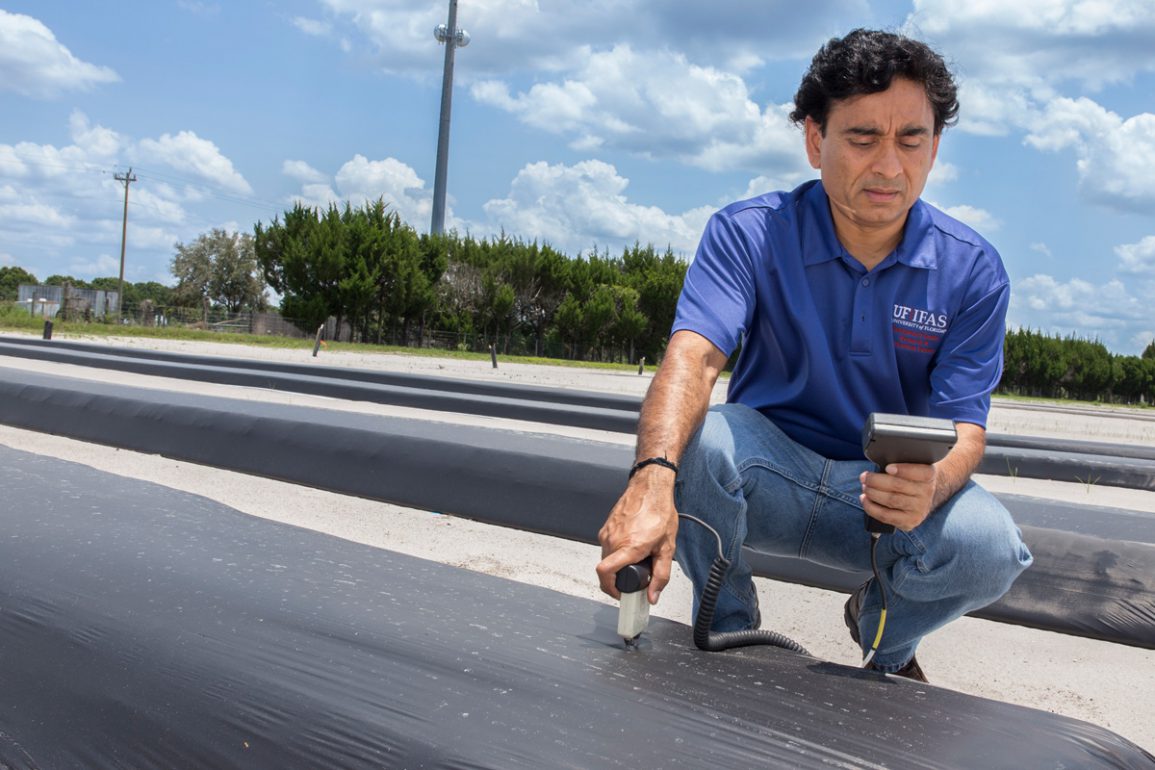Looking out over thousands of acres of tomatoes, Miguel Talavera, director of East Coast growing operations at Pacific Tomato Grower, Ltd., marvels at the narrow lanes of fruit that are thriving in the hot Florida sun. Talavera credits increase in yield and a decrease in the use of fumigants to a collaboration with researchers and Extension faculty at the University of Florida Institute of Food and Agricultural Sciences.
Three years ago, Talavera began working with Sanjay Shukla, a professor in the agricultural and biological engineering department based at the UF/IFAS Southwest Florida Research and Education Center in Immokalee, Florida. Shukla was researching what he calls “compact bed geometry,” which is used in plasticulture. Plasticulture – the use of plastic in agriculture – is used globally to produce high-value vegetable (e.g. tomato, pepper, eggplant) and some fruit crops.
The crops are grown on raised soils beds that are covered with plastic. The plastic mulch protects the crops from pests including weeds, provides a warmer soil environment and protects the fertilizer from being washed away, Shukla said. The end result is a high yield and consistent fruit quality, he said.
The plants are watered though plastic drip tubes which also carries fertilizer with them. Fumigants are mixed in the soil bed to protect the crop from disease, Shukla said. And, the wider the bed, the more the fumigant is needed, he added.
Instead of planting crops on beds that were normally 6 to 8 inches high and about 3 feet across, Shukla planted them 10 inches to a foot high and 1 ½ to 2 feet across. The crops were more narrow and higher.
With the compact bed designs, Shukla and his team in an undergoing experiment were able to demonstrate that farmers could still produce the same crop but with lower inputs, including cost. This meant that producers that use two drip tapes can now use only one without sacrificing production, he said.
The results have been astounding. Instead of needing two drip lines to irrigate each row, crops require only one, Talavera said, thereby reducing the amount of water used. In addition, crops need fewer square feet in plastic mulch covering.
“We save about 10 percent in fumigants, and increased our yield and the quality of the fruit,” Talavera explained. “We are using this method on our farms in Immokalee and Parrish, Florida. But, we will probably expand it to our locations in Georgia and California.”
Other growers, too, have seen success with Shukla’s compact bed geometries. “The farmers who adopt compact beds to grow peppers, the second most valuable vegetable crop in Florida, can save close to $300 per acre,” Shukla said. “Now, the pepper growers can plant double rows of peppers on the narrower and taller beds with just one drip tape. And, because they are using less input to grow the crop, they can save about $4 million to $6 million each year if it was used on 30,000-acre of pepper producing farms, even with a conservative savings of $200/acre.” Currently, there are more than 60,000 acres of farmland nationwide that are planted with pepper, Shukla said.
Shukla, who also has a UF/IFAS Extension appointment, also hopes to help other growers, small and commercial, who lease land to produce pepper. Compact beds leave more open space in the field because of reduced width.
So, growers can fit in more plant rows within the same field and may be able to cut down on the cost to lease land, he said.
“Growers can pay about $500 to $2,000 per acre to lease the land. So, if they are able to fit in more beds and get just 10 percent more produce per acre, then they save $50 to $200 per acre on the conservative side, just by changing to compact bed design,” he said. In addition to the saving the plastic cost at the planting, it also reduces the plastic disposal cost for growers who pay to dispose the plastic, Shukla explained.
According to Shukla, compact beds not only helps growers, but also aid the environment. “We are looking to redesign farms to make them more efficient, environmentally friendly and profitable,” he said. “it is an idea which has taken off, and we are continuing to test different compact bed designs for additional benefits such as reduced flooding damage and disease risk. We hope to come up with designs for other crops grown with plasticulture in the future.”

